If you want to break that mold and learn about the best antifreeze you can get for your vehicle, you have come to the right place. Drivers all around the world are known for underestimating the somewhat intricate parts of engine maintenance, some through stubbornness and some through inexperience. One such case is the antifreeze coolant solution. People just do not pay enough attention to it.
On top of that, we also went through the most popular antifreeze solutions out there and curated antifreeze reviews for you to consider when you decide to apply the newly-acquired knowledge. We invite you to stay and read about this (some would say) magical liquid that keeps the engine purring!
See The Quick Comparison Chart
Benefits of Antifreeze
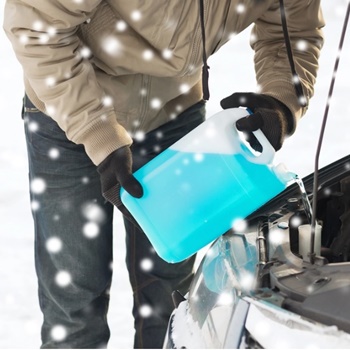 We have stressed out the importance of antifreeze due to its physical features. Before we talk about the sole benefits, it is crucial to understand that antifreeze and coolant solution is not there to replace water but to help it maintain its function instead. Without water in the cooler, the components of the car’s engine would start breaking down pretty soon. Now, water on its own is all that is necessary for the cooling compartment to function, but water is not known for being too resilient.
We have stressed out the importance of antifreeze due to its physical features. Before we talk about the sole benefits, it is crucial to understand that antifreeze and coolant solution is not there to replace water but to help it maintain its function instead. Without water in the cooler, the components of the car’s engine would start breaking down pretty soon. Now, water on its own is all that is necessary for the cooling compartment to function, but water is not known for being too resilient.
1. Overheating Prevention
So, the very first benefit of using an adequate antifreeze solution is overheating prevention. Overheating happens more often than you think, especially during hot summer days. When the summer heat hits, water tends to evaporate much, much faster from the cooling tank, and making up for lost water is a hassle. Technically speaking, if you got out of the vehicle every hour and poured new water into the tank, you wouldn’t need antifreeze or coolant. But, because that is extremely impractical, using antifreeze saves time and prevents overheating all at once.
2. Freezing Prevention
Another benefit of using quality antifreeze is, as the name suggests, freezing prevention. As soon as outside temperature drops and winter chill hits, the water in the cooling tank will start to solidify. By mixing an antifreeze solution with the water, you prevent it from freezing, thus enabling engine cooling at extremely low temperatures. Putting the right amount of antifreeze is a winterizing tip for cars.
Additionally, there is another benefit to freezing prevention. As you probably know, water tends to expand while it turns into ice. This water property may seem harmless, but if you happen to have a full water cooler when the water starts freezing, you risk severe damages to the entire cooling system. Pipes may break, and tubes may burst. Antifreeze prevents this expansion with easy, thus saving your vehicle from potential damages.
3. Cooling System Maintenance
Lastly, the third significant benefit of antifreeze/coolant solutions is rust prevention and corrosion removal. Since it is logical for water tanks to have some degree of rust inside, antifreeze solution comes with formulas that prevent further corrosion, and even help with flushing out older sediments of rust. If it builds up, rust can plug the pipes, making the cooler stop working altogether. Rust is a major concern for older vehicles, or vehicles that use dirty water as a cooling liquid. Tap water speeds up the corrosion process to a degree, and antifreeze solutions (especially ones made for the US market) prevent and stop rusting in total.
Best Antifreeze Comparison Chart
| PRODUCT | DETAILS | ||
|---|---|---|---|
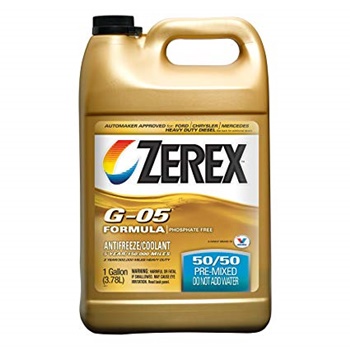 | Valvoline Zerex G-05 Antifreeze/Coolant |
| View On Amazon |
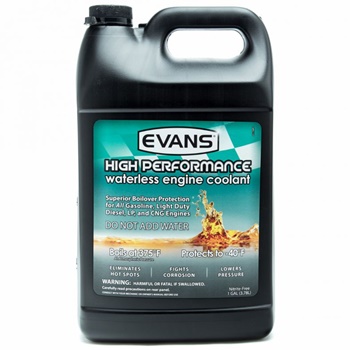 | EVANS Cooling Systems EC53001 |
| View On Amazon |
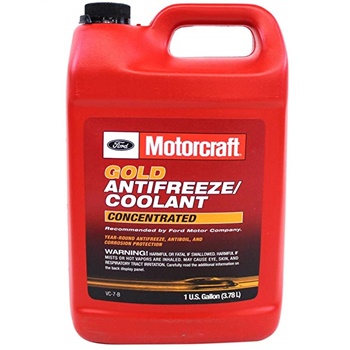 | Genuine Ford Fluid VC-7-B Gold Concentrated Antifreeze/Coolant |
| View On Amazon |
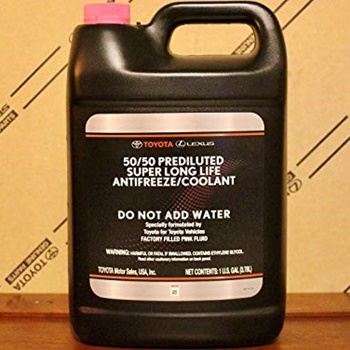 | Genuine 00272SLLC2 Engine Coolant / Antifreeze |
| View On Amazon |
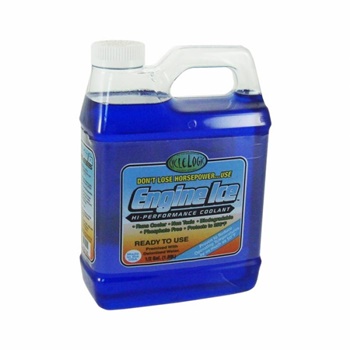 | Engine Ice TYDS008 High-Performance Coolant |
| View On Amazon |
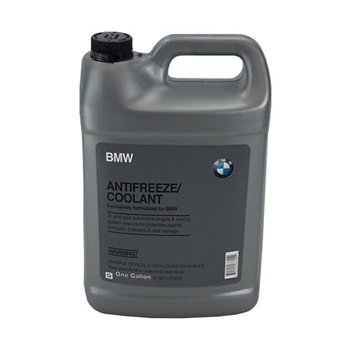 | BMW 82141467704 Coolant / Antifreeze |
| View On Amazon |
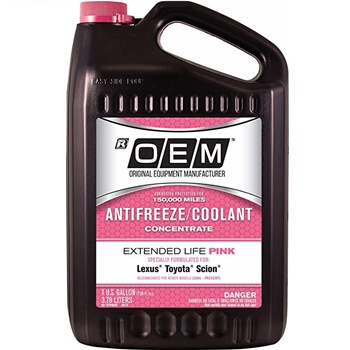 | Recochem OEM 86-174POEM Pink Premium Antifreeze |
| View On Amazon |
Best Antifreeze Reviews
1. Valvoline Zerex G-05 Antifreeze/Coolant
 The Valvoline Zerex G-05 is a concentrated formula, meaning that the gallon provided will last you for 2 gallons of total coolant liquid. The formula is made with eco-friendliness in mind, and the package contains minimal amounts of silicates, which protect your car from corrosion and make sure that already accumulated rust goes away without causing damages.
The Valvoline Zerex G-05 is a concentrated formula, meaning that the gallon provided will last you for 2 gallons of total coolant liquid. The formula is made with eco-friendliness in mind, and the package contains minimal amounts of silicates, which protect your car from corrosion and make sure that already accumulated rust goes away without causing damages.
This particular antifreeze formula contains no phosphates, making it less toxic for the environment. When it comes to performance, Volvo guarantees a total of 150,000 miles of regular usage or 300,000 miles of heavy-duty usage. The nitrites inside make this antifreeze friendly towards both diesel and gasoline engines.
Pros
- Phosphate-free antifreeze fluid, making it eco-friendlier than average
- Eligible for both diesel and gasoline engine use
- Has additives that protect your car’s water tubes and water reservoir
Cons
- The fluid needs to be mixed with water, making it hard to use in emergencies
- IT comes with a slightly higher price for its class
2. EVANS Cooling Systems EC53001
 EVANS is a known player in the game of antifreeze and coolant solutions. This particular coolant formula was designed to cover a wide range of vehicle engine types and manufacturing years. The fluid itself is waterless, which is a decision brought with eliminating corrosion in mind. The original bottle packs 128 fl. oz. of liquid, which is more than enough to get your car’s cooling system up and running.
EVANS is a known player in the game of antifreeze and coolant solutions. This particular coolant formula was designed to cover a wide range of vehicle engine types and manufacturing years. The fluid itself is waterless, which is a decision brought with eliminating corrosion in mind. The original bottle packs 128 fl. oz. of liquid, which is more than enough to get your car’s cooling system up and running.
This antifreeze does not boil quickly because it moves the boiling point up to 375° F, making it an excellent choice for hotter climates. And if it comes to boiling, the vapors of this fluid are low pressure, meaning that they do not exert a lot of stress on the cooling system components.
The manufacturer specifically stressed out the importance of draining out the old coolant before you pour this one in. This goes towards water-based coolants especially.
Pros
- This antifreeze formula is suitable for a wide range of vehicles that contain different engine types
- The solution fluid protects from -40° F and boils at 375° F
- The fluid does not put a lot of stress on the cooling system’s parts
Cons
- Some users reported that diesel engines run a bit hotter while using this antifreeze, which is fine because it has a higher than average boiling point of 375° F
3. Genuine Ford Fluid VC-7-B Gold Concentrated Antifreeze/Coolant
 There is a wide variety of Ford vehicles on the streets today, from town cruisers to sports cars. Ford decided to make this concentrated antifreeze agent cover the vast majority of its vehicles, regardless of its engine type. Both gas and diesel engines are fair game to this coolant.
There is a wide variety of Ford vehicles on the streets today, from town cruisers to sports cars. Ford decided to make this concentrated antifreeze agent cover the vast majority of its vehicles, regardless of its engine type. Both gas and diesel engines are fair game to this coolant.
The antifreeze is yellow-colored, and even though people like to mix the same colored antifreeze together, Ford specifically asked their customers not to do it in this case. This particular solution has a bittering agent which does not do well if mixed with non-adequate formulas.
Using this antifreeze, either pure or in a 1:1 ratio with distilled water, you will lower the freezing point of water in your car to -34° F, and raise the boiling point to 265° F.
Pros
- This formula covers a wide variety of Ford vehicles
- It can be used both in pure and 1:1 diluted form
- The antifreeze contains anti-boil and anti-corrosion additives which preserve the car’s cooling system
Cons
- Made specifically for a brand
- This antifreeze does not mix well with other types
4. Genuine 00272SLLC2 Engine Coolant / Antifreeze
 A popular pink antifreeze fluid, made specifically for Toyota, and vehicles made by Toyota, like Lexus is. This 1-gallon pack comes prediluted, and the manufacturer strongly advises against mixing any more water into the system. While mixing it with other coolants is also not recommended, if you really must do it, make sure that the pre-existing solution is eligible for mixing with water-based coolants.
A popular pink antifreeze fluid, made specifically for Toyota, and vehicles made by Toyota, like Lexus is. This 1-gallon pack comes prediluted, and the manufacturer strongly advises against mixing any more water into the system. While mixing it with other coolants is also not recommended, if you really must do it, make sure that the pre-existing solution is eligible for mixing with water-based coolants.
This pink coolant supports Toyota vehicles made in 2008 and after, but some users report that it works on slightly older light-duty cars as well. First-generation Lexus cars are also supported. The solution comes pre-mixed.
Pros
- A pink antifreeze that supports every Toyota and Lexus vehicle out there
- Works great on older cars and 1st generation Lexus
- Comes premixed in a 1:1 coolant to water ratio
Cons
- Does not mix well with other pink antifreeze/coolant solution
5. Engine Ice TYDS008 High-Performance Coolant
 If you are looking for a non-toxic, environmentally-friendly coolant mix, this Engine Ice formula might just be the right choice. Even though it comes in a smaller, .5-gallon container, it brings some less-common features to the table. This blue liquid is an all-around solution that supports a wide variety of vehicles, both residential and sport ones.
If you are looking for a non-toxic, environmentally-friendly coolant mix, this Engine Ice formula might just be the right choice. Even though it comes in a smaller, .5-gallon container, it brings some less-common features to the table. This blue liquid is an all-around solution that supports a wide variety of vehicles, both residential and sport ones.
The main ingredient is propylene glycol, which is known to be far less toxic than ethylene glycol found in almost every coolant out there. This formula also has no phosphates and is biodegradable. The boiling point is raised to 256° F, and the freezing point is lowered to -26° F, which is considered suitable for every climate condition.
Pros
- A non-toxic, biodegradable formula containing the less-damaging propylene glycol
- Approved for a large variety of vehicles, including some high-end sports cars
- Has a wide temperature range for a non-toxic formula (from -26° F to 265° F)
Cons
- Comes in a smaller container of .5 gallons
- Does not mix well with other antifreeze types
6. BMW 82141467704 Coolant / Antifreeze
 Here we have an antifreeze/coolant solution made for BMW vehicles specifically. It comes in a 1-gallon container, and it is recommended to all BMW owners that have a car made after 1992. Even though it is safe to use in its clean form, mixing it with distilled and demineralized water is also an option, especially in hotter climates.
Here we have an antifreeze/coolant solution made for BMW vehicles specifically. It comes in a 1-gallon container, and it is recommended to all BMW owners that have a car made after 1992. Even though it is safe to use in its clean form, mixing it with distilled and demineralized water is also an option, especially in hotter climates.
This formula provides excellent thermal protection, with a particular accent on freezing prevention. The freezing point is moved to -62° F, which is more than enough to endure even the roughest of winters. And, in the case you decide to mix it with water for better results, this German manufacturer recommends a 1:1 antifreeze to distilled water ratio.
Pros
- Precision German engineering made for BMW vehicles
- Covers al BMW made after 1992
- Can be used both in its pure form or mixed with water in a 1:1 ratio
Cons
- Made specifically for BMW vehicles
- It is a bit pricier considering the narrow niche
7. Recochem OEM 86-174POEM Pink Premium Antifreeze
 Here we have a concentrated pink antifreeze solution. It is an OEM (Original Equipment Manufacturer) designed to service Lexus, Toyota, and Scion vehicle models made from 2004 onwards. The coolant comes in pure form in a 1-gallon container.
Here we have a concentrated pink antifreeze solution. It is an OEM (Original Equipment Manufacturer) designed to service Lexus, Toyota, and Scion vehicle models made from 2004 onwards. The coolant comes in pure form in a 1-gallon container.
This particular solution belongs to the OAT group, meaning that it is less harmful to the environment that the inorganic antifreeze fluids out there. Additionally, this organic liquid has no traces of silicates nor borates, making it less toxic for humans as well (caution is still advised). However, there are still phosphates inside, which paly the role of cooling system lubrication and preservation.
The antifreeze is made for light-duty vehicles but has long-lasting durability of 150,000+ miles.
Pros
- The solution is free of silicates, borates, nitrites, and amides, making it slightly more eco-friendly
- The pink solution is made to service Asian made cars (Toyota, Lexus, Scion)
- As an OAT, it contains phosphates which protect the cooling system of your car
Cons
- Does not mix well with other pink antifreeze/coolant solutions
- Made for light-duty vehicles
What Does Antifreeze Do?
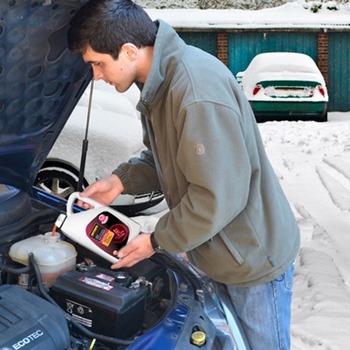 This question has kept a lot of people out of the light for a long time. People think that the science around antifreeze is not easily understandable, so they decide to quit it altogether. There are some complicated chemical and physical principles involved, but that doesn’t mean that we cannot tackle the subject from a practical point of view. So, what does antifreeze (engine coolant) actually do?
This question has kept a lot of people out of the light for a long time. People think that the science around antifreeze is not easily understandable, so they decide to quit it altogether. There are some complicated chemical and physical principles involved, but that doesn’t mean that we cannot tackle the subject from a practical point of view. So, what does antifreeze (engine coolant) actually do?
You are probably aware of the fact that car engines essentially run thanks to the series of extremely controlled mini explosions inside, hence the name “internal combustion engine.” The two main liquids involved are water (for cooling purposes), and of course gas (which explodes and combusts). It goes without saying that water is as crucial for your car to move as gas is, due to the fact that it cools down the whole engine system, allowing it to combust again and again.
If the injection of this water is somehow obstructed, your engine will have a bad time, being it a complete shutdown, or in worse cases, physical damage. The water flow usually stops either due to the evaporation or freezing, or to put it in simpler terms: either your car runs out of cooling water, or the water freezes entirely. That is where the chemistry of antifreeze kicks in.
The Power Of Antifreeze
Try imagining it like this. Water freezes on 32° F. If you inject a coolant/antifreeze mix into the water tank, this point will shift lower, thus allowing the water to stay in a liquid state, providing necessary cooling to the engine. On the other hand, water boils once it reaches 212° F. With a coolant mixture inside, this point goes up, preventing the water from evaporating so fast in order to keep cooling the engine.
Now, the number of degrees the freezing and boiling point will move from the standard 32° F and 212° F depends on the type of antifreeze, and on the amount of antifreeze in the mixture. We will, of course, touch upon that topic in the sections to follow.
What Are Antifreeze Types?
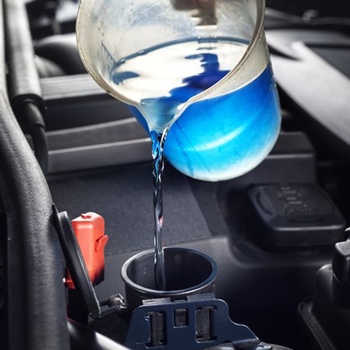 When it comes to dividing antifreeze types into groups, we can choose from several criteria. Dominant ingredient, color, temperature scaling, etc. These are all valid features that can be compared from brand to brand. But, if we want to cast the widest net, and cover as much as possible, the most important criterium for antifreeze types is the mix of ingredients inside the bottle, or at least the active, dominant type of ingredient. It might sound confusing at first, so let’s get into it and shed some light on this lesser-known antifreeze topic.
When it comes to dividing antifreeze types into groups, we can choose from several criteria. Dominant ingredient, color, temperature scaling, etc. These are all valid features that can be compared from brand to brand. But, if we want to cast the widest net, and cover as much as possible, the most important criterium for antifreeze types is the mix of ingredients inside the bottle, or at least the active, dominant type of ingredient. It might sound confusing at first, so let’s get into it and shed some light on this lesser-known antifreeze topic.
1. IAT – Inorganic Acid Technology
When you picture a standard antifreeze container, usually green in color, the chances are is that you are thinking about this type. The IAT has a well-known green color, and it is one of the most old-school antifreeze types out there. For the most part, IAT is used by older vehicles from the 90s and before. It is also a common antifreeze type inside trucks and bigger, stronger vehicles. However, due to technological advancements, better and safer types of antifreeze are available in today’s market.
The strong suit of IAT antifreeze is its ability to prevent corrosion, thanks to phosphates and a mix of ethylene glycol. On the other hand, inorganic liquids generally leave a harmful effect on rubber and plastic parts, like tubes, pipes and other plastic containers. Additionally, IAT is known to be not so environmentally friendly, and some states even banned the use of IATs, and are insisting on alternative antifreeze solutions out there.
Another vital thing to note about inorganic antifreeze solutions is that they need to be replaced every two years (or 30,000 miles) which is a significantly shorter lifespan compared to every other type of antifreeze/coolant solution out there.
2. OAT – Organic Acid Technology
If you own a newer vehicle, there’s a 50% chance that it uses some kind of organic antifreeze solution for its cooling system. Compared to its inorganic counterpart, OATs have a much longer (5 times longer) life span and can endure staying in the system for a total of 5 years, or 150,000 miles, before a drainage replacement is due.
The main thing with OATs is that they are less harsh on the environment that IATs. Even though they still bare the effects of anti-corrosion and rust prevention, they do not have phosphates and silicates inside their formula. Additionally, when it comes to the cooling system protection, and damage prevention, OATs are proved to be less harmful on the plastic and rubber parts inside the vehicle. Less damage to the pipes means a less overall risk for larger damages. Even though you can replace the smaller pipes for a small price, it is still a hassle, and no one should go through it.
OATs come in various colors and are typically packed diluted, with some exceptions of course. Their main active ingredient is ethylene glycol, which is the same as their IAT counterpart.
3. HOAT – Hybrid Organic Acid Technology
This type of antifreeze is considered to be the most common for modern-day cars. HOATs are even more eco-friendly than OATs, but they are not entirely safe, per se. While ethylene glycol is still the main active ingredient, HOATs rely on silicates for rust prevention and are recommended for vehicles that have a lot of aluminum parts built into the engine cooling system.
The standard color of HOAT antifreeze solutions may vary, but most commonly, you will find either yellow or bright orange. The mileage of HOAT solutions is similar to that of OAT, summing up at 150,000 miles or 5 years, depending on how you use your vehicle.
One important thing to bear in mind regarding hybrid organic antifreeze is that you can find solutions that utilize propylene glycol, which is way safer than the common ethylene glycol. If you put the environment high on your list, search for propylene glycol HOAT antifreeze solutions.
4. UAC – Universal Antifreeze Coolants
While they can be mostly made of IAT, HOAT or OAT, universal antifreeze solutions are premixed, in a 50/50 ratio of active agent and demineralized water. Out of all antifreeze types, the universal solution makes the smallest impact on the rubber and plastic parts of the cooling system, but they also contain the least silicates that play an important role in water tank protection and rust prevention.
Due to their low silicate concentration, they are eco-friendly and still get the job done. The colors of UAC may vary, but it will always be a more opaque color due to the 50/50 dilution.
5. Non-Toxic Antifreeze/Coolant
Lastly, there is a type of antifreeze out there which is considered safe for the environment, and even safe for consumption (which we strongly advise against). These non-toxic solutions mainly consist of propylene glycol, and they contain no phosphates nor silicate parts.
The main usage of non-toxic coolants is for preserving plumage and drinkable water pipes (due to its non-toxicity), but there are brands out there that are used as vehicle antifreeze solutions. Bear in mind that due to the absence of anti-corrosive agents, non-toxic antifreeze is not efficient in protecting the insides of your car’s cooling system and water tank.
Antifreeze vs. Engine Coolant
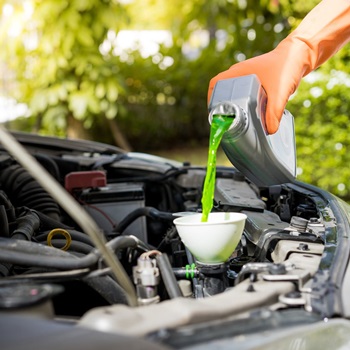 Even though people still consider that antifreeze and coolant are not the same things, the fact of the matter is that they are. There is a slight difference in the delivery of the formula, but the active ingredients are the same in both solutions.
Even though people still consider that antifreeze and coolant are not the same things, the fact of the matter is that they are. There is a slight difference in the delivery of the formula, but the active ingredients are the same in both solutions.
The actual difference in delivery is the percentage of water. What people call “coolant” is actually a container of pre-diluted antifreeze solution. And, when people refer to “antifreeze,” they actually think of a concentrated, water-free formula.
So, do not be confused if we use these two terms interchangeably, because they essentially talk about the same formula.
How to Pick an Adequate Antifreeze Type for Your Car?
Firstly, we want to stress out that you can not put any kind of coolant/antifreeze solution into your car. It might seem like a logical choice, but if you just go with “whatever” option, you risk engine misfires and potential damages.
Now, the absolute safest way to know which coolant goes into your car cooling system is to check the user manual you got with the car in the first place. However, we are aware of the fact that most people (especially owners of older vehicles) do not have the original manuals anymore. Having that in mind, we will present some simple ways to check and make sure you are using the right antifreeze/coolant solution.
1. Check the Box
Antifreeze manufacturers tend to put a lot of info on the labels to help you out in choosing the correct solution. Sometimes, this will include the model or the year of your car, and sometimes it will be the engine type, or sometimes all of the above. The point is, you should probably study the label and find out as much as possible.
2. Match the Color
This is not the happiest of solutions, but if you are stuck with an empty cooling system, or you urgently need to refill your car’s coolant storage, matching the antifreeze color is the way to go. Color coding of antifreeze solutions is actually designed for the purpose of helping you choose the correct coolant. However, this method may put you at risk of choosing a slightly different coolant type.
3. Ask Around
There aren’t many types of car antifreeze liquids out there. One of the safe methods in determining which type your car needs is to ask your local town mechanic or vendors at the gas station. The chances are that they will instantly know which coolant you need to buy, just by looking at your car.
4. Check Under the Hood
Lastly, if you want to double-check, or want to be certain that you are getting the right coolant type, open up the hood and look for the cooling system. There’s a significant chance that you will find the coolant type info somewhere on the water tank or the water tank cap. We recommend using a flashlight because these marks are usually barely visible.
Antifreeze Buying Guide
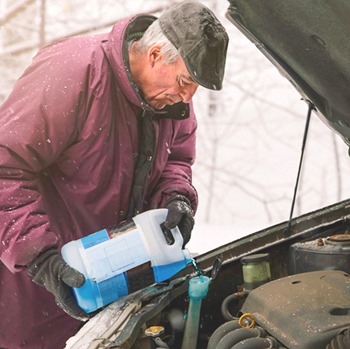 Every manufacturer and type bring something slightly different to the table when it comes to coolant fluids. Besides, regarding the total number you can choose from, not every coolant solution or antifreeze is good for your vehicle. Let us dive in into the intricacies and differences that coolants could have, and help you choose the right one for your car.
Every manufacturer and type bring something slightly different to the table when it comes to coolant fluids. Besides, regarding the total number you can choose from, not every coolant solution or antifreeze is good for your vehicle. Let us dive in into the intricacies and differences that coolants could have, and help you choose the right one for your car.
1. Color
This feature will catch your eye immediately (pun intended) because the color of antifreeze actually says a lot about its quality and overall type. We did talk about the chemical origin of coolants, and their color definitely has a part to play but is not a 100% indicative of the quality of ingredients. So, here’s a list of commonly found color in antifreeze solutions.
- Green and bright green – this color usually tells us that it is an inorganic antifreeze solution. It is somewhat stronger than the others, but it needs to be changed more frequently and has lesser total mileage. IATs are used, as we mentioned above, in older cars, and they contain phosphates and silicates to prevent rust and corrosion.
- Pink and purple – these colors are usually connected to some form of organic antifreeze solutions. Pink coolants are most commonly used by newer Audi and VW vehicle models.
- Orange and dark yellow – If the color is solid orange that it is another standard organic solution, used in GM cars. If the color goes to yellowish, it is probably a hybrid organic antifreeze, and it is most commonly used in Chryslers.
- Red – The chances are that this is another organic/hybrid organic coolant solution, most commonly used by Toyotas.
- Solid Green – If it is not an IAT, solid green antifreeze is probably an organic type, used in Hondas.
2. The Origin
When we talk about antifreeze origin, we usually refer to the OEM/generic debate. Even though there isn’t a clear consensus among car owners about which one you should take, there certainly are benefits to it. Original Equipment Manufacturer, or OEM for short, tells us that the antifreeze manufacturer also made the parts inside the cooling system of your car.
By this logic, you should always aim to get an OEM for your vehicle. However, there are exceptions. Sometimes, especially in the case of older vehicles, you will not be able to match the type of coolant and the manufacturer. In this case, the only thing you can do to make sure everything stays in order is to switch out for another generic brand.
If you have to go down the way of generic brands, fear not, there are easy solutions for that kind of scenario. All you have to do is make sure that the old antifreeze is drained out completely before you switch. If you are not sure which type to pick as the new one, you can always consult the user manual of your car, or simply as a local town mechanic.
3. Safety and Toxicity
Unfortunately, when it comes to coolants and antifreeze solutions, the lesser toxic types are usually less effective, at least when it comes to vehicles use. We talked about general types based on the chemical compounds inside, so we would lie to suggest a short checklist of chemicals and their effect-to-safety correlations.
- Phosphates – they are mostly found in IATs and older antifreeze types. Phosphates help with water cooling system maintenance, however among the other ingredients, they are potentially the most toxic part of coolant solutions.
- Silicates – Found in almost every type of antifreeze. Silicates are less dangerous than phosphates but are toxic nonetheless. They work best in aluminum water reservoirs.
- Ethylene glycol – The main active ingredient of modern-day antifreeze. Ethylene glycol helps water achieve the thermo-versatility. This substance is quite toxic to the human body.
- Propylene glycol – Found in less potent antifreeze fluids. However, propylene glycol is the least toxic among these ingredients, both for humans and the environment.
4. Vehicle Engine Compatibility
If you want to make sure that the coolant you are using is compatible with your car’s engine, all you have to do is know if it’s a diesel or a gas one. Diesel is known for being “less clean,” and engines running on it tend to suffer the wear-out faster. The same rules apply for octane boosters or other engine supplements.
So, if you have a diesel vehicle, you should look for an antifreeze solution that has a lot of protective supplements (with silicates and phosphates being the two main groups). On the other hand, if your vehicle’s engine is running on gasoline, you do not have to worry about extra-protective coolants. Just pick one out using the data we provided and pour properly.
How to Tell if it’s the Right Time to Change the Antifreeze in Your Car?
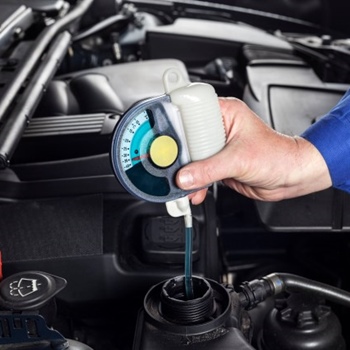 There is no “one fits all” method when it comes to antifreeze change. It is true that coolants lose their abilities over time, including not only the temperature features but also their lubrication abilities and anti-rust properties. For the sake of keeping the engine of your car in a healthy state, it is important to avoid running the engine with a stale coolant inside.
There is no “one fits all” method when it comes to antifreeze change. It is true that coolants lose their abilities over time, including not only the temperature features but also their lubrication abilities and anti-rust properties. For the sake of keeping the engine of your car in a healthy state, it is important to avoid running the engine with a stale coolant inside.
Color Test
The simplest way to know if it is time to change or not is to do a simple color test. Often times, somewhere on the original coolant box, there will be a stripe of color representing fresh antifreeze color. Use this method and compare the antifreeze in your car’s cooling system to the default color. If it’s off, the chances are it is time for a change.
Mileage
Another thing you could do to track the state of coolant freshness inside your car is to check on the mileage. For example, if a coolant solution lasts for 150,000 miles, write down the mileage on the box, and once it gets close to the limit, check on the state of the coolant. This applies for work hours as well, but tracking time is less accurate, and generally harder to do.
Generally speaking, you can see that the coolant is closing its expiration date by tracking the amount of water your vehicle uses to cool down the engine. If you have to pour in more water than usual, it is probably time to think about antifreeze change, because it is a clear sign that the one inside is not doing its job well. You can also do a smell test if necessary, but it is not a recommended method because of the ethylene glycol’s toxic properties. If the coolant smells like it burned out, it is stale and needs a change.
Owner’s Manual
Finally, as repetitive as it sounds, you should check the owner’s manual you got with your vehicle. You will surely find crucial info regarding antifreeze change frequency inside the manual, and some car manufacturers even provide useful tips on how to do it, related to that particular car model. Treat the seriousness of antifreeze as you would treat the seriousness of the best brake fluids. Better safe than sorry, right?
Remember, if you are in an emergency, and your car ran out of antifreeze(or your RV antifreeze), you can always use more water, until you get to a safe spot at least. Your car will burn through the water quickly, yes, but it will save your engine from serious damages. After all, coolant solutions are there to keep that water inside for a longer time.
FAQ About Antifreeze & Coolants
1. Can I mix the old coolant with the new one?
Technically, there is nothing stopping you from doing so, because the downsides are not that dangerous, and you cannot damage the engine beyond repair. However, there are a few safety tips you should bear in mind if you decide to just fill up the tank before draining it first.
- Mixing coolants is an ok thing to do if you are sure that the solution in the tank isn’t stale.
- Always match the color and type of the antifreeze solutions you are mixing.
- If you see that the engine is not responding well, do a total drain and start over.
- Be careful about the amounts to prevent antifreeze leak
2. Can I mix antifreeze fluid based on ethylene glycol with the fluid based on propylene glycol?
While propylene glycol is known to be less toxic and slightly less potent that ethylene glycol, mixing the two together will not bring any harm to the engine or the cooling system of your vehicle. Do not expect that one type of alcohol will enhance the features of the other. They will function well when mixed.
Keep in mind that ethylene glycol is much more poisonous and bad for the environment and that if you pour the less toxic propylene glycol in, it will not decrease the overall toxicity of the solution. All in all, this kind of combination is absolutely safe for your engine.
3. Is used up antifreeze still toxic?
While coolants will use their thermal and protective abilities once they’re done, the toxicity level will stay relatively the same. Please have in mind that antifreeze solutions are extremely toxic for animals and humans, no matter if they used or not. We strongly recommend extra caution levels while draining the old antifreeze and while pouring new antifreeze into your car’s cooling system. A pair of protective rubber gloves and a respiratory mask will do the job.
4. How to Dispose Of Antifreeze?
Additionally, once you are done with the old batch of coolant, make sure to do antifreeze disposal properly, according to the laws in your state. Antifreeze is not to be spilled freely into the environment. Get a sealed container and drain the old fluid into it to prevent antifreeze poisoning.
Wrap Up
And there you have it. Everything you need to know about engine coolants, and all the necessary knowledge needed to get the best antifreeze for your car. There is plenty of choice on today’s market, and we suggest the route of arming yourself with knowledge while using your guide as a checklist. After all, once you’ve gone through the important stuff, have a look at our antifreeze reviews and apply your newly-acquired knowledge by getting a pack for your car.
People usually do not take the time to learn about coolants, and oftentimes, they underestimate the importance of having a trustworthy antifreeze inside the cooling system of their mechanical friend. It is time to break through that mold and fight the general ignorance. After all, it will save you the time and money needed for repairs caused by broken cooling pipeage. Stay cool!